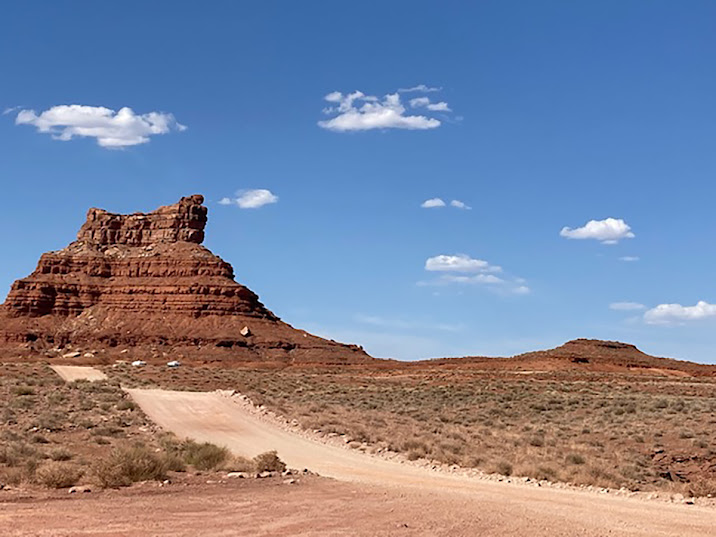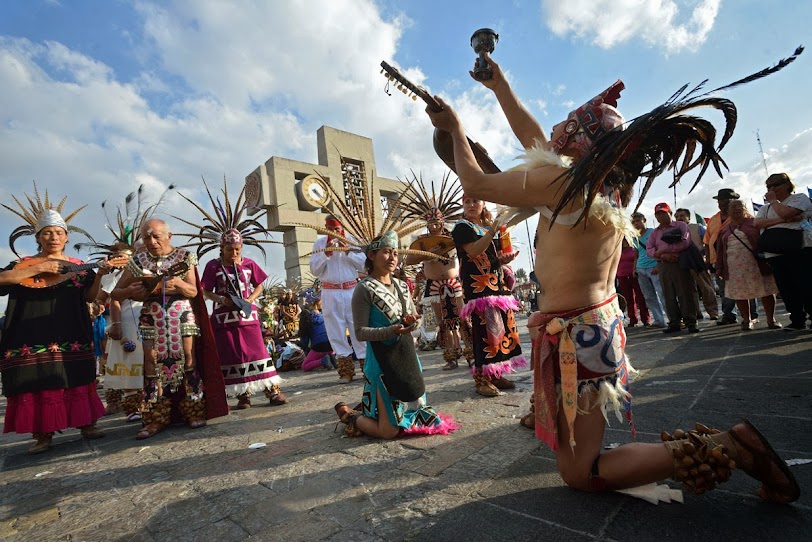The Reluctant Tourist on the Navajo Nation
 | |
Photo: Avelardo Valdez | |
By Avelardo Valdez
I am in Mexican Hat, Utah, a way station along the San Juan River in the northern reaches of the Navajo Nation. We’ve just left the Valley of Gods, where massive and majestic mesas—the largest cluster in the world—rise from the desert floor like ancient temples.
Leaving a dusty road that runs through the Valley of the Gods, we make a wrong turn and endldez up on the steep, gravel-covered switchback route which leads to the 1200-foot summit of Cedar Mesa. Correcting our course, we circle back to Highway 63 and head south. Exhausted from two-hours of hard driving, we pull up to Mexican Hat’s lone 7-Eleven. In dire pursuit of water and snacks, we enter the store in haste.
Although I know the answer, I ask the clerk, a young Navajo man, where I can buy alcohol as he tallies up our purchases. “Liquor is banned on the Navajo reservation. Closest place to buy is 40 miles away,” he replies. Put to every local person encountered on this trip up to now, my question is really just a pretext meant to engage local stakeholders in more extended conversation.
Before I can get my next question in, the cashier asks me where I am staying. I tell him we’re lodged at The View Hotel on the reservation near Kayenta. I complain to him that everything—from restaurants, bars and hiking trails to guided tour operations across 14 million acres of reservation land encompassing parts of Arizona, Utah and New Mexico—is closed.
I ask him if he knows when the reservation will reopen. “The Navajo Nation Council is not going to fully open the reservation for another year. It’s for protection of the Code Talkers whose families are from this Valley. They fought in WW II and served our nation just like other Navajo men from here who fought in Korea and Vietnam. Their families are all still here. They were here before the tourists came.”
This is their land and families that live here need to be protected from outsiders likely to transmit the COVID-19 virus. I sense that he regards the spread of COVID on the reservation as a continuation of the historical atrocities committed by interlopers. His point is valid since in the early phase of pandemic the Navajo people suffered some of the highest infection and death rates in the country. In response, the Navajo National Council (NNC) had closed off much of the reservation’s public areas, limiting access to pueblos and other native attractions.
A billboard I noticed upon first entering the Navajo territorial boundaries announced a reservation-wide curfew from 11 p.m. to 6 a.m. Anyone traveling through or residing within the reservation was legally required, noted the billboard, to wear a mask when in view of others. The mandate applies to both in-door or out-door activities equally. These restrictions go beyond those recommended by the Centers for Disease Control & Prevention (CDC). The NNC, I learn, had been accused by some health officials of not taking the spread of the virus as seriously as it should early on.
I concern myself with the conditions that would have caused the virus to spread so rapidly among the Diné at the onset of the global pandemic as I had been, so some degree, impressed by the stark immensity of the barren terrain, a vast, sparsely populated expanse of dry land and desert country.
Residents live in small wood and adobe frame houses, or in trailers comprising family compounds. From the highway, it appeared that most properties included several single-family housing units as well as corresponding pens or corrals for sheep, horses and other livestock. The sight of multiple late-model vehicles—many in what I guessed might be varying states of disrepair—parked throughout the property did not surprise me. Most of the compounds are set so far from the road that their isolation, as well as their poverty, is underscored.
These, however, are just my own impressions because I have not been near those homesteads or the families living there. Remember, I am only a tourist, like thousands of others from around the world who come to see the natural stone monuments etched into our imaginations by TV westerns, the iconic films of John Ford, and a photographic archive that stretches back for well over a century.
After my exchange with the convenience store clerk, I jump back into the car with my travel companion. He is a friend of over 40 years who convinced me to take a road trip with him. He was eager for a temporary break from his spouse, adult children, and grandchildren in San Francisco, where he’s been locked up in his home since the start of the COVID-19 pandemic. I am on this excursion for similar reasons.
I tell him what the young clerk said to me about the NNC’s rationale for the lockdown. He answers back somewhat factiously, “Yeah, that’s what they are saying now. But there is too much money being made from tourism. Tourists are what keeps this Valley’s economy going. Capital will win out in the end. They’ll be open soon.”
So how is life on the reservation for these Native Americans? Has tourism actually improved the quality of their lives? I have since learned that tourism accounts for roughly 20 percent of the Navajo nation’s economy. Overall, annual family income on the reservation is one of the lowest in the U.S. The unemployment rate has hovered around 45 percent for the last decade. Most who work are governmental employees. The reservation also has some of the highest indicators of health disparities in the country.
In my opinion, tourism does not truly impact the economic growth or the sustainability of this area to the degree my friend asserts.
A conversation the following morning with the receptionist at our hotel, also Native, provides some interesting insight. Asked how people make a living here, she responds at length. “Years ago, people here made a living from raising livestock like sheep and cattle. The making of movies provided lots of work for native peoples. Now, not so much.”
“So now people make jewelry, weave blankets and other craft items, but less than before because lots of the elderly are dying off and young people aren’t into that,” she continues. “Some of the families rent horses for trail riding and others give tours to the back country. Also, people now are renting their places for vacation rentals.”
Hearing this, I think to myself that it might be a good thing for the NNC to open the tourist businesses. But she goes on, as if in response to my silent observation. Her words resound with a deeper, more meaningful truth.
“People have been living here forever. The rights of those properties are given to them by the elders and are passed down through the families. My family has had this property for generations, as she points to the land on either side of the road leading to the hotel. I live right down there. This is sacred land,” she concludes. “And we will never leave it. We don’t want outsiders to spoil it or change how we live. That’s what the tourists do to us.”
Attachment to the land and the preservation of their cultural traditions continue to be highly valued by the Navajo people. Insofar as tourism or other industries and businesses are compatible with their cultural values and do not threaten the social fabric of this community, they are welcomed. Yet for the Navajo, economic progress cannot come at the expense of their way of life. History has taught them that the biggest threats they face are often brought in from without, usually with good intentions.
On the same night, the hotel screens John Ford’s Stagecoach on a two-story wall facing a hotel balcony. A life-sized John Wayne races across the valley astride his horse, the archetypical mesa as backdrop and native Navajo actors giving fierce chase on their war-paint adorned ponies.
It’s a strange and ironic moment for me as a tourist and a non-Native Mexican American. A privileged hotel guest, I sit on the balcony and follow the images projected onto the vertical brick surface across from me. I can help but consider how my presence here in Monument Valley as an outsider and my exoticization of the West as it is portrayed in this 1938 film are actually contributing to the demise of a culture, and the people who struggle to maintain its integrity. In this, I fear, I’m one more among those like me who have come before.




Comments
Post a Comment